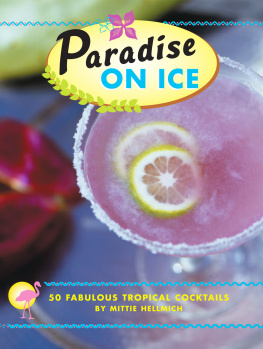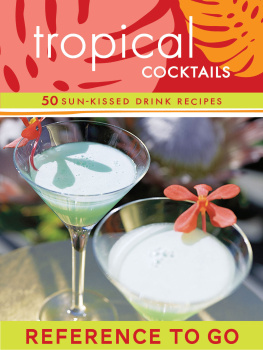Table of Contents
Mini Bar Vodka
Mini Bar Whiskey
Mini Bar Gin
Mini Bar Tequila
Mini Bar Vodka
by MITTIE HELLMICH
photographs by Laura Stojanovic

Introduction
THE MEANING OF THE WORD VODKA IN RUSSIANLITTLE WATERPERFECTLY CHARACTERIZES THIS CLEAN AND MOST NEUTRAL OF ALL SPIRITS. WITH VIRTUALLY NO DISCERNIBLE FLAVOR OR AROMA, VODKA IS THE CHAMELEON OF LIQUORS, MELDING SEAMLESSLY INTO ANY MIXOLOGICAL CONCOCTION.
This crystal-clear spirit may be synonymous with the chilly northern and eastern European cultures of Scandinavia, Russia, Poland, and the Ukraine, but it was the alchemically inclined Italians who brought the art of distillation to the area. Northern Europeans, however, can take credit for distilling vodka to perfection. Ever since, they have consumed it like, well, wateras a bracer against the harsh northern winters and a potable balm to bolster the spirits. Although they say that the farther north the vodka hails from, the better it is, there are always exceptions. France has brought its refined palate into the vodka market with a few remarkable premium vodkas, including Ciroc, which is distilled from grapes.
Vodka is typically made from either potatoes or grains such as rye, wheat, corn, and barley. Most vodkas are distilled in continuous stills, where the spirit is heated, cooled, and then filtered to remove unwanted trace elements such as botanicals and minerals that would otherwise lend flavor and aroma. Some, however, are made in old-fashioned pot stills to retain a whisper of original flavor.
Vodka can be made from virtually any botanical substance, because once it has been distilled, the spirit is filtered through activated charcoal to remove any remaining impurities and harsh edges, resulting in a neutral, clean taste. Yet, even in highly filtered spirits, the original substance influences the outcome. For example, potatoes characteristically produce vodka with a creamy quality, whereas rye-based vodkas have a bite and wheat-based spirits a more subtle delicacy. Unlike other spirits (with the exception of a few Polish and Russian vodkas aged in oak), vodka achieves its mild smoothness through multiple filtrations rather than through aging, with the highest-quality vodkas filtered many times. Some producers go to the extreme with exotic methods using silver birch charcoal or pure quartz sand; Suhoi vodka is purportedly filtered through diamonds.
Vodka has become the top-selling spirit in American bars, but this wasnt always the case. Virtually unknown outside northern Europe until the late 1940s, vodka was introduced to these shores by a Russian refugee named Vladimir Smirnoff. Vodka distiller to the czar, Smirnoff escaped to America after the Bolshevik Revolution and introduced his new country to the specialty of his homeland. For decades the exotic spirit was vaguely linked to dark Chekhov plays and Tolstoy novels. But in 1946 the Moscow Mule propelled vodka into the mainstream. Made with vodka, lime, and ginger beer and served in a copper mug, the cocktail soon tripled Smirnoffs sales. By the 1960s, vodka was firmly entrenched in our cocktail repertoire with drinks like the Screwdriver and the Bloody Mary. It even infiltrated the hallowed realm of the Gin Martini once James Bond glamorized his signature Vodka Martini.
The essentially neutral character of vodka makes it the most ideal spirit for mixing in a wide variety of cocktails. When it comes to the many vodka styles available, the best choice for mixed drinks is the moderately priced Russian, Scandinavian, and American vodkas for their clean, tasteless quality. Premium vodkas, typically from eastern Europe or France, tend to have more discernible aromatic whispers and nuances of flavor, from citrus and sea spray to herbs, spices, or pepper. These spirits should be savored, so reserve your high-end vodkas for icy shots, Martinis, and Vodka Tonics. The most distinctive feature of vodka, often taken for granted, is its mouthfeel, or how it feels in the mouth and on the palate. Whether the texture is oily or soft, viscous or buttery, it is all part of the vodka experience.
With the exception of an elite group of Vodka Martini fans, Americans are an eccentric lot, preferring to mix their vodka in a variety of cocktails. Russians, Poles, Swedes, and western Europeans still enjoy their vodka neat, either as an aperitif before a meal or sipped as an after-dinner drink.
Key to enjoying vodka for vodkas sake is to chill it in the freezer, not only to enhance the flavor but also to promote its viscosity. The traditional ritual of serving vodka straight from the freezer neat, in a small glass, is the best way to savor a great vodka. Although some enjoy it over ice, many purists find such a practice sacrilegious, as the vodka becomes too diluted. However, sipping anything less than a superpremium vodka will deliver a somewhat harsh finish sure to evoke Dostoyevskian angst.
The new darling of contemporary mixology may be flavored vodkas, but the techniques used to make them date back to the eleventh and twelfth centuries, when Polish and Russian households began adding herbs, spices, and fruits to vodka to help mask the harsh taste of rudimentary distillates. Today theres an ever-widening selection of mouthwatering flavored vodkas on the market, from lemon and orange to raspberry, mandarin, grapefruit, peach, chocolate, black currant, apple, pepper, cranberry, and vanillanot to mention easily homemade infusions with personalized botanical combinations. They have opened up a whole new world of creative options, adding an extra flavor dimension to cocktails.
So, before the clinking of glasses and the toasting starts, consider the possibilities beyond traditional shots of vodka. This little book will lead you into the world of the Cosmopolitan and the Lemon Drop, inviting you to shake or stir your way through a fabulous collection of swank and sophisticated cocktails, refreshingly fizzy coolers, and luxuriously creamy nightcaps, all made with enticing ingredients that embrace vodka in all its versatile glory.
Za vashe zdorovye! (To your health!)
Glassware, Tools, and Terminology
Glassware
Glassware plays an important role in the much-ritualized cocktail experience. A well-chilled vessel visually entices us with the promise of refreshment, with the right glass adding elegance to even the simplest drink. Glasses come in an endless variety of designs, styles, and colors, but when it comes to setting up your home bar, your repertoire of glassware doesnt have to be extensive to be stylishly appropriate and proficiently functional. A few basic stylescocktail glasses, highball glasses, old-fashioned and double old-fashioned glasses, champagne flutes, and wineglasseswill see you beautifully through a multitude of drinks.
Essential Bar Tools
Whether you have a swank bar setup in your favorite entertaining room or an area set aside in the kitchen, you dont need all the high-tech gadgets and gizmos to put together a well-functioning home bar. All you need are the essential bar tools to see you through just about any mixological occasion. You may already have the typical kitchen tools you need: a sharp paring knife for cutting fruit and garnishes, a cutting board for cutting fruit, a bar towel, a good corkscrew and bottle opener, and measuring spoons and cups. To these you will want to add a few of the basic bar tools: a blender with a high-caliber motor, a citrus juicer, a cocktail shaker or a mixing pitcher and stirring rod, a bar spoon, a jigger, an ice bucket and tongs, and, of course, a few cocktail picks and swizzle sticks.









